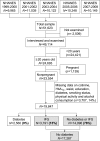Relationships of cotinine and self-reported cigarette smoking with hemoglobin A1c in the U.S.: results from the National Health and Nutrition Examination Survey, 1999-2008
- PMID: 21836101
- PMCID: PMC3177720
- DOI: 10.2337/dc11-0710
Relationships of cotinine and self-reported cigarette smoking with hemoglobin A1c in the U.S.: results from the National Health and Nutrition Examination Survey, 1999-2008
Abstract
Objective: Whether nicotine leads to a persistent increase in blood glucose levels is not clear. Our objective was to assess the relationship between cotinine, a nicotine metabolite, and glycated hemoglobin (HbA(1c)), an index of recent glycemia.
Research design and methods: We used cross-sectional data from the National Health and Nutrition Examination Survey (NHANES) from 1999 to 2008. We limited our analysis to 17,287 adults without diabetes. We created three cotinine categories: <0.05 ng/mL, 0.05-2.99 ng/mL, and ≥3 ng/mL.
Results: Using self-report, 25% of the sample were current smokers, 24% were former smokers, and 51% were nonsmokers. Smokers had a higher mean HbA(1c) (5.36% ± 0.01 SE) compared with never smokers (5.31% ± 0.01) and former smokers (5.31% ± 0.01). In a similar manner, mean HbA(1c) was higher among participants with cotinine ≥3 ng/mL (5.35% ± 0.01) and participants with cotinine 0.05-2.99 ng/mL (5.34% ± 0.01) compared with participants with cotinine <0.05 ng/mL (5.29% ± 0.01). In multivariable-adjusted analysis, we found that both a cotinine ≥3 ng/mL and self-reported smoking were associated with higher HbA(1c) compared with a cotinine <0.05 ng/mL or not smoking. People with a cotinine level ≥3 ng/mL had a relative 5% increase in HbA(1c) compared with people with a cotinine level <0.05 ng/mL, and smokers had a relative 7% increase in HbA(1c) compared with never smokers.
Conclusions: Our study suggests that cotinine is associated with increased HbA(1c) in a representative sample of the U.S. population without diabetes.
Figures
References
-
- Al-Delaimy WK, Willett WC, Manson JE, Speizer FE, Hu FB. Smoking and mortality among women with type 2 diabetes: The Nurses’ Health Study cohort. Diabetes Care 2001;24:2043–2048 - PubMed
-
- Willi C, Bodenmann P, Ghali WA, Faris PD, Cornuz J. Active smoking and the risk of type 2 diabetes: a systematic review and meta-analysis. JAMA 2007;298:2654–2664 - PubMed
-
- Janzon L, Berntorp K, Hanson M, Lindell SE, Trell E. Glucose tolerance and smoking: a population study of oral and intravenous glucose tolerance tests in middle-aged men. Diabetologia 1983;25:86–88 - PubMed
-
- Sargeant LA, Khaw KT, Bingham S, et al. Cigarette smoking and glycaemia: the EPIC-Norfolk Study. European Prospective Investigation into Cancer. Int J Epidemiol 2001;30:547–554 - PubMed
-
- Modan M, Meytes D, Rozeman P, et al. Significance of high HbA1 levels in normal glucose tolerance. Diabetes Care 1988;11:422–428 - PubMed
Publication types
MeSH terms
Substances
Grants and funding
LinkOut - more resources
Full Text Sources
Medical
Miscellaneous


